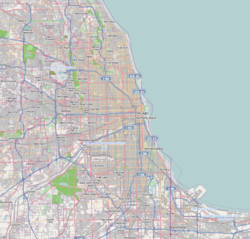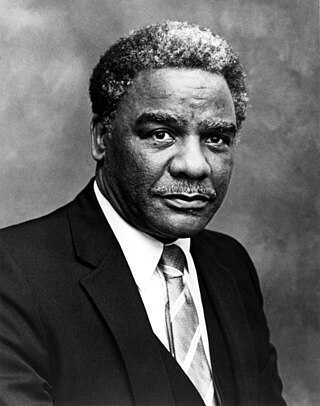
Harold Lee Washington was an American lawyer and politician who was the 51st Mayor of Chicago. Washington became the first African American to be elected as the city's mayor in April 1983. He served as mayor from April 29, 1983 until his death on November 25, 1987. Born in Chicago and raised in the Bronzeville neighborhood, Washington became involved in local 3rd Ward politics under Chicago Alderman and future Congressman Ralph Metcalfe after graduating from Roosevelt University and Northwestern University School of Law. Washington was a member of the U.S. House of Representatives from 1981 to 1983, representing Illinois's first district. Washington had previously served in the Illinois State Senate and the Illinois House of Representatives from 1965 until 1976.

The mayor of Chicago is the chief executive of city government in Chicago, Illinois, the third-largest city in the United States. The mayor is responsible for the administration and management of various city departments, submits proposals and recommendations to the Chicago City Council, is active in the enforcement of the city's ordinances, submits the city's annual budget and appoints city officers, department commissioners or directors, and members of city boards and commissions.
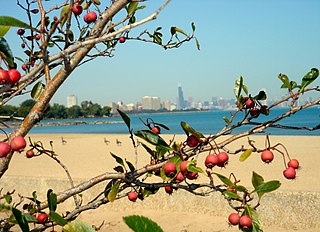
South Shore is one of 77 defined community areas of Chicago, Illinois, United States. Located on the city's South Side, the area is named for its location along the city's southern lakefront. Although South Shore has seen a greater than 40% decrease in residents since Chicago's population peaked in the 1950s, the area remains one of the most densely populated neighborhoods on the South Side. The community benefits from its location along the waterfront, its accessibility to Lake Shore Drive, and its proximity to major institutions and attractions such as the University of Chicago, the Museum of Science and Industry, and Jackson Park.
Dorothy Jean Tillman is an American politician, civil rights activist and former Chicago, Illinois alderman. Tillman served as the alderman of the city's 3rd Ward from 1985 until 2007. A member of the Democratic Party, representing part of the city's South Side in the Chicago City Council. As an Alderman, Tillman was a strong advocate of reparations for slavery. In April 2007, Tillman was defeated in a runoff election by challenger Pat Dowell. Tillman defeated Dowell in 2003. Prior to her career as an alderman, Tillman was active in the Civil Rights Movement, working for Martin Luther King Jr.'s Southern Christian Leadership Conference (SCLC) as an activist. Tillman was known for wearing large hats and has cultivated this image as her trademark.

Helen Shiller is a former Alderman of the 46th ward in Chicago, Illinois. Shiller is also a published author, having written a 500-page book on her politics and activism in Chicago from 1971 to 2011. Shiller served in the Chicago City Council for six four-year terms, from 1987 to 2011. Shiller was elected to the City Council on her third attempt, as Harold Washington, Chicago's first black Mayor, was re-elected to his second term, and her election as alderman helped close the Council Wars era in Chicago government. Shiller has been described as "a reformer unafraid totake on the boys in power." A less flattering description is that she is "committed to liberal causes and destroying all within her path". Among her most significant impacts on Chicago were her advocacy for diverse, inclusive, affordable housing and helping craft Chicago's response to the HIV/AIDS crisis. Her commitment to fostering community development without displacement often brought Shiller into contention with some constituencies, real estate developers, and editorial boards. Shiller's oral history was collected by Pulitzer Prize-winning author and Uptown resident Studs Terkel in his 2003 book, Hope Dies Last. As she details in her own book, among her policy victories as a City Council member was: getting human rights legislation passed, having Chicago implement anti-apartheid legislation, creating a City Council Subcommittee on Domestic Violence, and building a unique mix-used development.

Douglas, on the South Side of Chicago, Illinois, is one of Chicago's 77 community areas. The neighborhood is named for Stephen A. Douglas, Illinois politician and Abraham Lincoln's political foe, whose estate included a tract of land given to the federal government. This tract later was developed for use as the Civil War Union training and prison camp, Camp Douglas, located in what is now the eastern portion of the Douglas neighborhood. Douglas gave that part of his estate at Cottage Grove and 35th to the Old University of Chicago. The Chicago 2016 Olympic bid planned for the Olympic Village to be constructed on a 37-acre (15 ha) truck parking lot, south of McCormick Place, that is mostly in the Douglas community area and partly in the Near South Side.

Grand Boulevard on the South Side of Chicago, Illinois, is one of the city's Community Areas. The boulevard from which it takes its name is now Martin Luther King Jr. Drive. The area is bounded by 39th to the north, 51st Street to the south, Cottage Grove Avenue to the east, and the Chicago, Rock Island & Pacific Railroad tracks to the west.

Roseland is one of the 77 official community areas of Chicago, Illinois, located on the far south side of the city. It includes the neighborhoods of Fernwood, Princeton Park, Lilydale, the southern portion of West Chesterfield, Rosemoor, Sheldon Heights and West Roseland.

State Street is a large south-north street, also one of the main streets, in Chicago, Illinois, USA and its south suburbs. Its intersection with Madison Street has marked the base point for Chicago's address system since 1909. State begins in the north at North Avenue, the south end of Lincoln Park, runs south through the heart of the Chicago Loop, and ends at the southern city limits, intersecting 127th Street along the bank of the Little Calumet River. It resumes north of 137th Street in Riverdale and runs south intermittently through Chicago's south suburbs until terminating at New Monee Road in Crete, Illinois.

The history of African Americans in Chicago or Black Chicagoans dates back to Jean Baptiste Point du Sable’s trading activities in the 1780s. Du Sable, the city's founder, was Haitian of African and French descent. Fugitive slaves and freedmen established the city's first black community in the 1840s. By the late 19th century, the first black person had been elected to office.
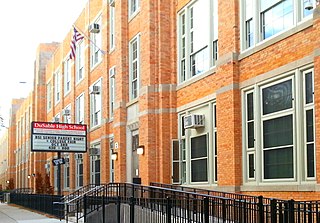
Jean Baptiste Point DuSable High School is a public four-year high school campus located in the Bronzeville neighborhood on the South Side of Chicago, Illinois, United States. DuSable is owned by the Chicago Public Schools district. The school was named after Chicago's first permanent non-native settler, Jean Baptiste Point Du Sable. Constructed between 1931 and 1934, DuSable opened in February 1935. Since 2005, the school campus serves as home to two smaller schools: the Bronzeville Scholastic Institute and the Daniel Hale Williams Preparatory School of Medicine. Both of the schools use the DuSable name in an athletics context. The DuSable Leadership Academy was housed at the location until it closed after the 2015–16 school year. The school building was designated a Chicago Landmark on May 1, 2013.

De La Salle Institute is a private, Catholic, coeducational secondary school run by the Institute of the Brothers of the Christian Schools in the Bronzeville neighborhood on the South Side of Chicago, Illinois, United States. It was founded by Brother Adjutor of the De La Salle Brothers in 1889.

The Black Metropolis–Bronzeville District is a historic African American district in the Bronzeville neighborhood of the Douglas community area on the South Side of Chicago, Illinois.
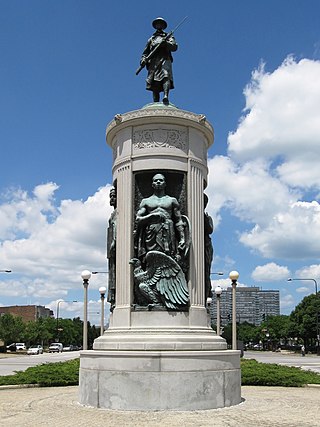
The South Side is an area of Chicago, Illinois, U.S. It lies south of the city's Loop area in the downtown. Geographically, it is the largest of the three sides of the city that radiate from downtown, with the other two being the north and west sides.

The Avalon Regal Theater is a music hall located at 1641 East 79th Street, bordered by the Avalon Park and South Shore neighborhoods on the south side of Chicago, Illinois, United States. It is a noted venue for African-American performers. The theater opened in August 1927.

Mirth & Girth is a portrait painting by School of the Art Institute of Chicago (SAIC) student David K. Nelson, Jr., depicting the deceased popular African-American mayor of Chicago, Harold Washington wearing only a bra, G-string, garter belt and stockings. After a brief showing at a May 11, 1988 private student exhibition in the Art Institute, angry African-American aldermen, including Ald. Allan Streeter, Ald. Bobby Rush and Ald. Dorothy Tillman, arrived with Chicago Police Department officers and confiscated the painting, triggering a First Amendment and race relations crisis and a civil lawsuit.

King-Lincoln Bronzeville is a historically African American neighborhood in Columbus, Ohio. Originally known as Bronzeville by the residents of the community, it was renamed the King-Lincoln District by Mayor Michael B. Coleman's administration to highlight the historical significance of the district's King Arts Complex and Lincoln Theatre, amid collaborations with investors and developers to revitalize the neighborhood.

Pat Dowell is a member of the Chicago City Council representing the City of Chicago's 3rd ward in Cook County, Illinois. Dowell was elected in April 2007 in a runoff election against incumbent Dorothy Tillman. Dowell had lost to Tillman in 2003. Dowell is a member of the City Council's Housing and Real Estate, Transportation and the Public Way, Landmarks, Rules and Health committees.

The Regal Theater was a night club, theater, and music venue, popular among African-Americans, located in the Bronzeville neighborhood in Chicago, Illinois. The theater was designed by Edward Eichenbaum, and opened in February 1928. It closed in 1968 and was demolished in 1973.
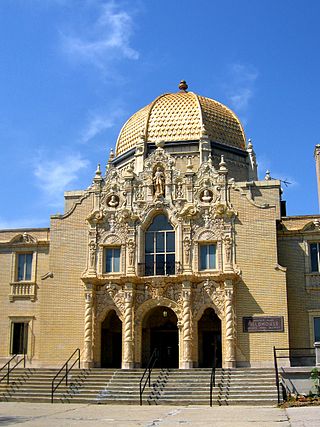
The West Side is one of the three major sections of the city of Chicago in Cook County, Illinois, along with the North Side and the South Side. The West Side consists of communities that are of historical, cultural, and ideological importance to the history and development of Chicago. On the flag of Chicago, the West Side is represented by the central white stripe.

